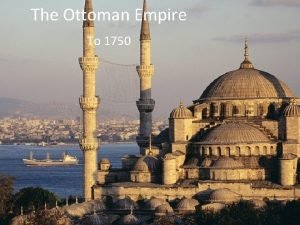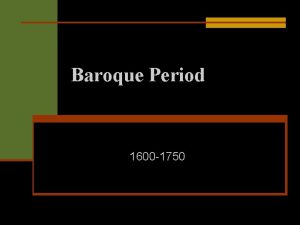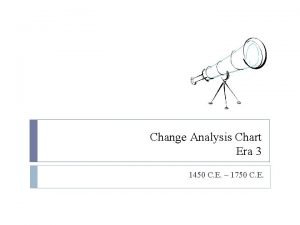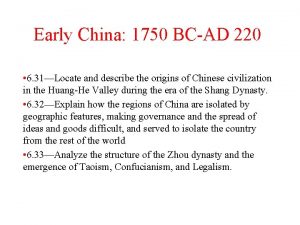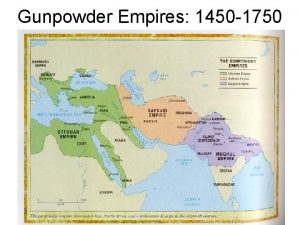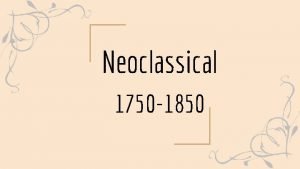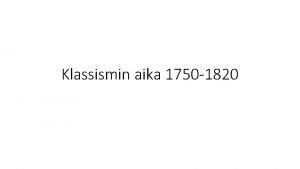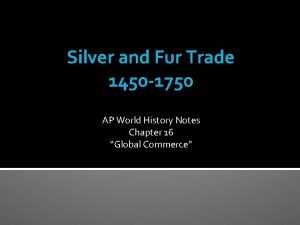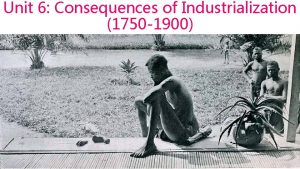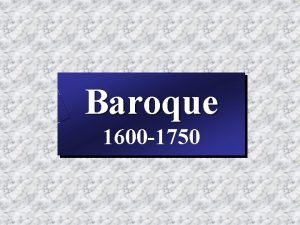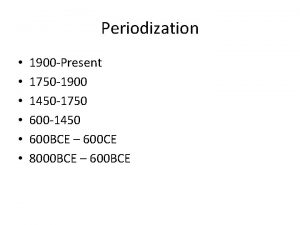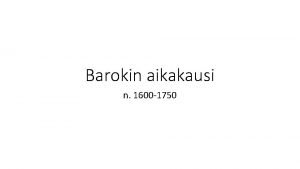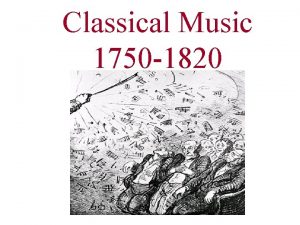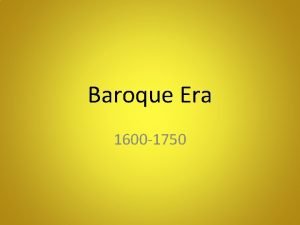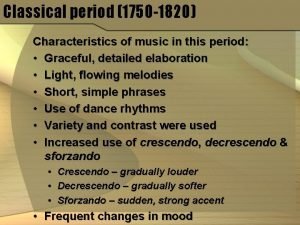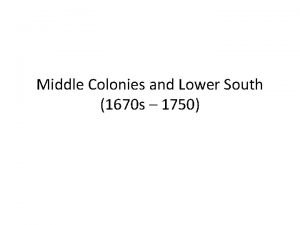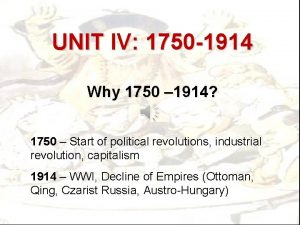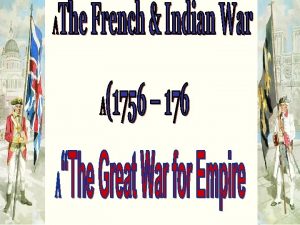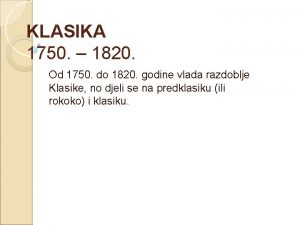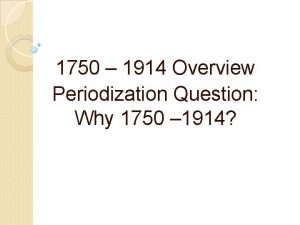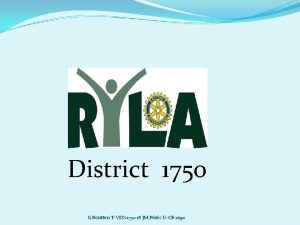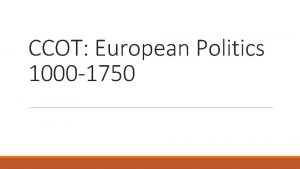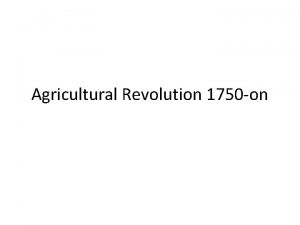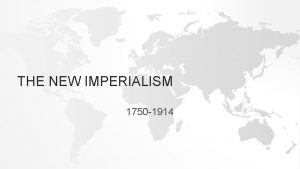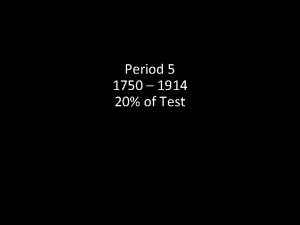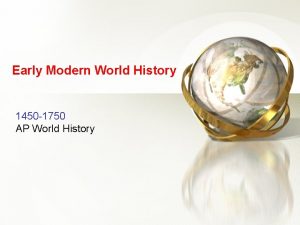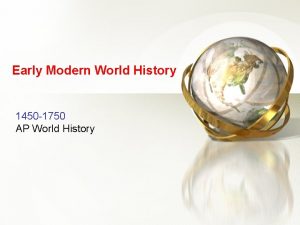THE WORLD IN 1750 The world in 1750



















- Slides: 19

THE WORLD IN 1750… The world in 1750 was marked by powerful Eurasian states and empires, coastal African kingdoms, and growing European maritime empires. The interaction of these states, empires, and kingdoms disrupted regional trade networks and influenced the development of new global trade networks.

KEY TERMS Absolute Ruler: Rulers who took complete control of their country using any means necessary. Religious Tolerance: Willingness to let others practice their own beliefs. Cultural Diffusion: Spreading of ideas from one culture to another.

Absolute Rulers: Attempted to centralize their control by limiting the power of the nobility.

Mughal Empire 1526 – 1857

Geography: • Empire included the Indian subcontinent (India and parts of modern day Pakistan). • Coastal trading centers

Main Leaders: • Babur – Descendent of Genghis Khan who founded the Mughal Empire. • Akbar the Great (1556 -1605) 1556 -1605 • • Absolute Ruler Created a highly organized Islamic state Practiced cultural diffusion and religious tolerance Considered to be the greatest ruler Increased trade Created stability and expanded empire Land Revenue System = people of the land were taxed in exchange soldiers to protect them in wartime. The tax had nothing to do with religion and helped Akbar to maintain control over the empire.

Ottoman Empire 1453 – 1922

Geography: • At its height, the Ottoman Empire included parts of Europe, Africa, and Asia • Geographic location guaranteed involvement in foreign trade.

Main Leader: • Suleiman the Magnificent • 1520 – 1566 • Also Known as “The Lawgiver” Lawgiver • Absolute Ruler • Religious tolerance and cultural diffusion • Ottoman Empire reached its height by 1566 under his leadership

Religious Elements: • Janissaries = Christian boys were taken from families, converted to Islam, and then rigorously trained to serve the empire. • Millets = areas where people can practice religions of choice…shows tolerance.

The Empire: • Ottomans main economic endeavor was agriculture • Domestic trade was much more dominant than foreign trade. • Beginning with the fall of Constantinople, the Ottoman Empire expanded quickly into lands in the Middle East, North Africa, the Caucasus, and Eastern Europe.

Practice Question: Which characteristic is associated with the rule of Akbar the Great and Suleiman the Magnificent? (1) promoting equal rights for women (2) expanding the role of legislative bodies (3) forcing the conversion of citizens to Christianity (4) practicing religious tolerance toward members of society

Practice Question: Which form of government is associated with the reign of Akbar the Great and Suleiman the Magnificent? (1) constitutional monarchy (2) direct democracy (3) theocracy (4) absolute monarchy

Tokugawa Shogunate

Geography: • Archipelago - A group of islands • • Neighboring countries: • China and Korea

Commercial Activity: • Primarily domestic with some close regional trade with Korea/China. • Agricultural in nature

Tokugawa Shogunate: • During the 1500 s, power was decentralized in Japan, which was torn apart by warfare between competing feudal lords (daimyo) for nearly a century. Following his victory in the Battle of Sekigahara in 1600, however, Tokugawa Ieyasu (1543 -1616) swiftly consolidated power from his heavily fortified castle at Edo (now Tokyo).

Tokugawa Shogunate: • The Tokugawa Shogunate desired isolation Japan was closed to foreigners (especially Christians). Christians • Only the Dutch were allowed to trade at the port city of Nagasaki • Edict of 1635: 1635 • No Japanese shall be sent abroad Anyone breaking this law shall suffer the penalty of death • The arrival of foreign ships must be reported to Tokyo and a watch kept over them. • The samurai shall not buy goods on board foreign

Tokugawa Shogunate: • Bushido Code - a strict code of behavior followed by samurai warriors in Japan. • Daimyos were closely monitored and required to spend significant time in Edo. • Rigid class system
 Ottoman empire in 1750
Ottoman empire in 1750 Buxtehude composer
Buxtehude composer Change analysis chart 1450 to 1750
Change analysis chart 1450 to 1750 1750 bc ancient china
1750 bc ancient china Land based empires 1450 to 1750
Land based empires 1450 to 1750 The death of marat medium
The death of marat medium La traviata juoni
La traviata juoni Fur trade ap world history
Fur trade ap world history Rhythm in baroque music
Rhythm in baroque music Migratio
Migratio 1750s music
1750s music 1750-1600
1750-1600 1900-1450
1900-1450 What period lasted from 1750-1825?
What period lasted from 1750-1825? Puhelaulunomaisia
Puhelaulunomaisia 1820-1750
1820-1750 Https://www.youtube.com/watch?v=afhpriozexe
Https://www.youtube.com/watch?v=afhpriozexe 1770s music
1770s music Franz joseph haydn characteristics of music
Franz joseph haydn characteristics of music Middle colonies
Middle colonies
